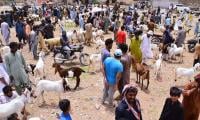It’s more than 10 months that the first case of the coronavirus was reported in the Wuhan province of China. For more than a month people thought it was, and would remain, confined to China.
But then countries one after another started reporting the emergence of coronavirus cases. Those who initially thought it was a local problem perhaps forgot that the world is now a global village not only in terms of technology but in terms of distances as well. Travel across continents is a norm.
According to Worldometer website, 213 countries and territories around the world have been affected by the virus. At present, the number of confirmed cases across the globe has surpassed 32 million, while more than 995,000 have died (September 26 figures). The US, India and Brazil have the most confirmed cases, though there is a renewed spike in infections in Europe, especially in the UK, Italy, and France.
In this bleak scenario, the only slightly good news is that around 22,466,000 of the infected people have recovered.
It is amazing how well-developed countries with supposedly best healthcare services are still unable to control the spread of the disease or even reduce mortality by coming up with a cure – a miracle drug. After months of research there is still no promise of a vaccine, though efforts are underway and human trials have begun in some countries, such as the US, the UK and China.
One can understand the failure of developing countries to contain the spread and death rate as they lack the resources to do so – their healthcare services are lacking in many aspects such as testing capacity and they are short of protective gear for healthcare personnel. But the case is different for developed countries. Even if they were caught unawares, enough time has lapsed in which they could have mobilised all resources and won the battle.
It is clear that the world was not expecting the disease to spread so much so as to become a pandemic. Even when cases started to emerge in one country after another, most of the initial cases were from people travelling from China who brought the virus. It still didn’t ring a bell nor raised alarm.
We have the case of Italy where the virus spread unnoticed; there are reports that though unusually high number of pneumonia cases were being observed, suspicions were not raised and even when a couple of cases were detected in tourists coming back from China, testing was concentrated on their contacts, ignoring local transmission, till the situation went out of hand. But once the cases started increasing the country took strict measures, shut all educational institutions, closure of all non-essential business activity and imposed a strict lockdown. Italy’s example shows how quickly and decisively action needed to be taken.
Now that almost the entire world is in the grips of the deadly disease, it is pertinent to take stock of the situation and try to analyse what went wrong and what lessons are to be learnt from it, leaving aside the conspiracy theories and blame game.
It is evident that countries which acted swiftly and took a hard-line approach of strict lockdown, such as New Zealand’s ‘go hard and go early’ policy and Vietnam where the government acted swiftly to suspend flights, close schools and quarantine new arrivals.
It seems that the countries that are worst affected are those which did not take the threat seriously at the initial stages. As often happens, there was a sort of denial, not accepting that it could take a serious turn and not taking serious measure to control the spread – both at the government and the public level. In many countries, lockdowns were not either taken seriously by the public or the authorities to impose them strictly.
Pakistan, too, faced a lot of challenges in the beginning as neither the public nor the government took the threat seriously, going on to the extent of calling it a mere flu. When the cases began to rise, health professionals raised alarm as the country’s healthcare system is in a poor state and we lacked testing capability and protective gear for the health professional. To add to that, few people were following protective SOPs such as wearing masks and maintaining social distancing. In May, whatever lockdown was in place was lifted as businesses and markets were allowed to open.
It was feared that a disaster was waiting to happen as people went about their business and Eid shopping, but then, after the initial surge, miraculously the world saw that the cases in Pakistan started to drop and the curve began to bend. Some believed that testing was not being done, while others blamed the authorities for doctoring figures. But the world acknowledges that Pakistan has somehow managed to tame the beast. Even the World Health Organisation (WHO) has included Pakistan among the countries that the world needs to learn from.
Yet, it seems we are still not out of hot waters and need to be careful. Not only is the number of daily infections rising again, indicating a second surge, but a study conducted by the Aga Khan Hospital has sent alarm bells ringing. According to the study, 9 out of 10 people in Karachi – considered by experts as one of the epicentres of the disease in Pakistan – who tested positive for Covid-19 are asymptomatic, which means they do not show any symptoms of the disease but can transmit it to others. The report says that the ratio of asymptomatic cases in Pakistan is much higher than the developed countries. The research also confirmed the findings of an earlier study conducted by the government, which had concluded that 11 percent of the population had contracted the disease, using results of an antibody test.
At this stage, it is important that, while the situation is still under control, we should not lower our guard or revel in the success and praise, but rather take the pandemic seriously and make all out efforts to reverse the rising trend by strictly following the SOPs and increasing our testing capability as well as being vigilant in all spheres.
Studies need to be conducted to ascertain under what circumstances the virus spreads, in order to develop effective preventive measures to break the chain of transmission so as to make it easier to contain it. As the increase has coincided with the opening of educational institutes, it is important to regularly monitor students, teachers and other staff.
The writer is a freelance journalist.
Twitter: @naqviriz
People stand in line up as election officials check their ballot papers during voting general election at a polling...
Women show their voter identity cards as they stand in a queue before casting their votes in Agartala. — PTIThe 18th...
Former prime minister Imran Khan. — Instagram/ imrankhan.ptiAn old saying has it that “when you dance with the...
Kashmiris in Indian illegally occupied Kashmir protesting against the Indian occupation as the forces of India looked...
A representational image showing residents walking at a wholesale market in Karachi. — AFP/FileOnce again there is...
A representational image showing late Pakistani human rights activist and Supreme Court lawyer Asma Jahangir. —...







